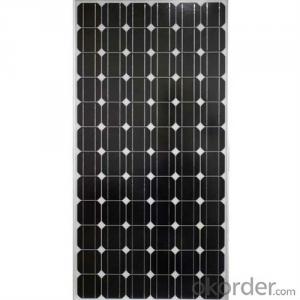Mono Solar Module 156*156 PV module high performance
- Loading Port:
- China main port
- Payment Terms:
- TT OR LC
- Min Order Qty:
- 50 pc
- Supply Capability:
- 50000 pc/month
OKorder Service Pledge
OKorder Financial Service
You Might Also Like
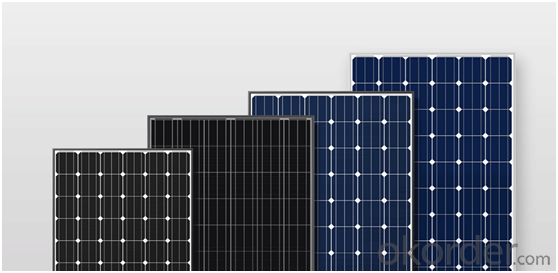
Specification:
· Highest performance enabled by higher efficiency monocrystal line cells and the latest Solar Wafer Technology for multicrystal line cells
· Lower weight design which reduces the total system load on a roof, making it ideal for residential customers. Its shape allows for better roof utilization
· Its low weight means easier handling for installers
· Modules are designed to withstand PID (Potential Induced Degradation)*
· High light transmission Anti-Reflective Glass with improved self-cleaning capability
· 0/+5 W Positive power tolerance for reliable power output

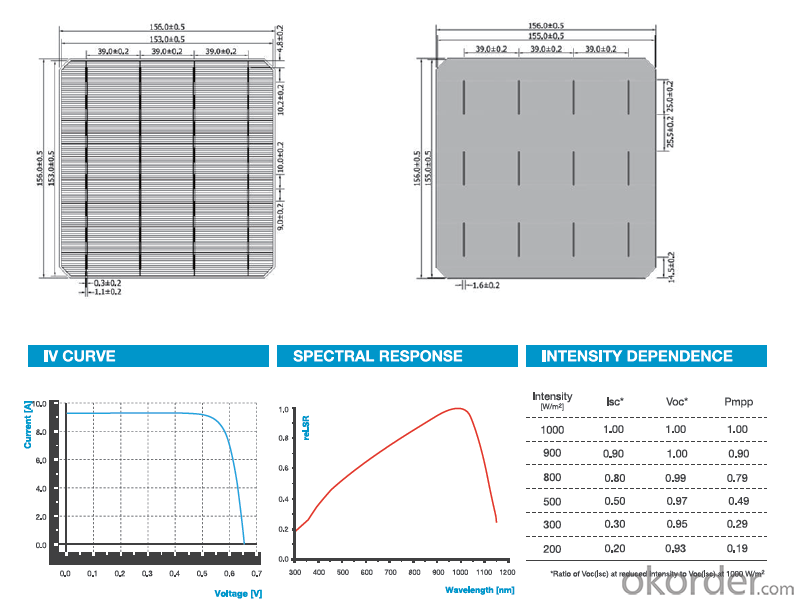
Warranty
CNBM Solar provides one of the most comprehensive module warranties in the industry:
· 10 years for product defects in materials and workmanship
· First 12 years for 90% of warranted minimum power
· Remaining 25 years for 80% of warranted minimum power
Certification
CNBM Solar strictly carries out the ISO 9001 quality control methodology and has implemented check points at every step of the production process to ensure our product performance durability and safety. The stringent quality control process has been confirmed by numerous independent agencies and LDK Solar modules earned IEC, TUV and UL certifications.
· IEC:IEC 61215, IEC 61730 (1&2), conformity to CE
· UL 1703 2002/03/15 Ed:3 Rev:2004/06/30
· ULC/ORD-C1703-01 Second Edition 2001/01/01
· UL and Canadian Standard for Safety Flat-Plate
· ISO 9001: 2008 Quality Management Systems
· CEC Listed: Modules are eligible for California Rebates
· PV Cycle: Voluntary module take back and recycling program
· MCS Certificate


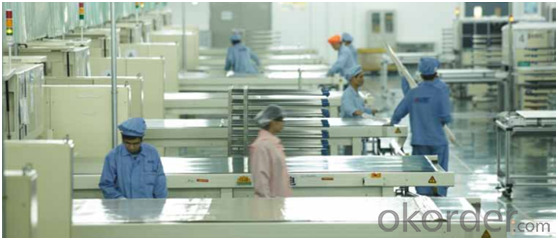
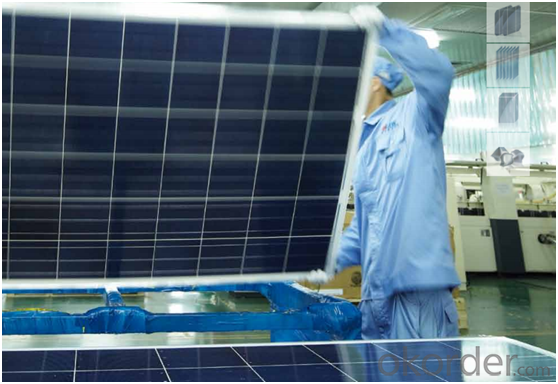
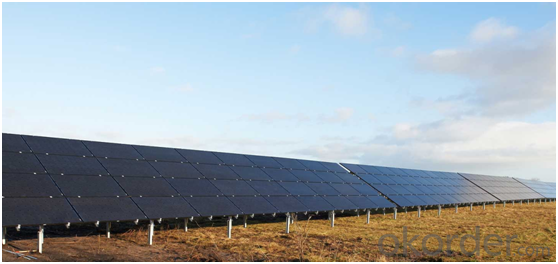
FAQ
Q: How long has Solar PV technology been around?
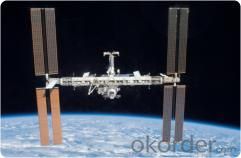 In 1838 the photoelectric effect was discovered by physicist Edmund Becquerel although it wasn't until the 1950's that the technology was developed enough to produce efficient working cells.
In 1838 the photoelectric effect was discovered by physicist Edmund Becquerel although it wasn't until the 1950's that the technology was developed enough to produce efficient working cells.
Q: Are Photovoltaic panels expensive?
Over the last 20 years the price of PV modules has fallen dramatically, from around £15 per Wpk in 1980 to current prices of around £3.50 per Wpk.
Q: Will I have to get planning permission?
Not in the vast majority of cases. However if you want your system ground mounted, if your property is part of a world heritage site, or is listed, then planning permission would likely have to be sought in advance.
Q: How long will a Solar PV system last?
The MCS accreditation scheme means that all panels installed under the scheme by approved agents will continue to generate for at least 25 years. Over this time their output will diminish slightly but they should still perform at 85% at the 25 year mark according to the scheme rules.
Q: How much Power can I expect to get from my Solar PV’s?
Typically an installed 1kWpk array will produce 800kWh/year. 2kWpk will produce 1600kWh/year and so on.
Q: How much will I get paid for the electricity I feed into the grid?
If you install a qualifying small system (1-4kWpk) in the UK before October 2012 you will get paid 16 pence for every kWh you generate regardless of whether you use it yourself or export it to other users. This is a generation tariff or feed in tariff.
Q: Is it true that I can get my electricity meter can spin backwards?
Not usually, nor is it legal to do this. The very old meters may cause this to happen however the company installing your PV will advise you if you need to ask for a meter replacement from the company supplying your electricity. This is usually free of charge.
- Q:Can solar panels be installed on a residential community?
- Yes, solar panels can be installed on a residential community. Many residential communities have implemented solar panel systems to generate clean and renewable energy for homes. These installations can help reduce electricity costs, decrease reliance on fossil fuels, and contribute to a more sustainable living environment.
- Q:I don't remember what number exactly but it's in the single digits. This number represents how efficient solar panels are at capturing the sun's rays and converting it into electricity.Why?
- There are a lot of solar panels available today's. The problem of the efficiency is the proccess of converting, these cells use the photons of the sun to react with the ( Si compound inside the cell) due to the little thing that cell's are only a fraction of these energy is converted, remember that solar cells are paper thin and the really problem of these cells are the voltage not the amps. A single 3x6 inches solar cells can produce 3.6 amps but only 0.5 volts.
- Q:i have 2 questions.. I have a 6v solar panel, if i wanted to charge batteries with that it what batteries could i charge? Could charge normal AA batteries with it our do i need special batteries.2. I have a 6v solar panel that produces watt. I want to light a bulb with it but whenever i hook it up the solar panel won't light it up. I think the current of the solar panel is too low. How can i increase the current of the solar panel
- [] Use it to charge 4 pieces AA cell ( connect in series to make 5V battery pack ) for 0 to 4 hours. Good for cell rated 600mAH ,2000mAH,2500mAH. [2] Cannot increase current. Buy some more this panel and hook them together in parallel to increase current. You need at least ten pieces to make current reaches .6A to light up some 6V bulbs.
- Q:How do solar panels affect the overall carbon footprint of a building?
- Solar panels can significantly reduce the overall carbon footprint of a building. By harnessing clean and renewable energy from the sun, solar panels generate electricity without emitting greenhouse gases. This means that the building relies less on fossil fuel-based electricity, reducing its carbon emissions. Additionally, solar panels can offset the energy consumption of a building, further minimizing its carbon footprint, making it a sustainable and environmentally-friendly choice.
- Q:I have 2 solar panels one is 5 watts 2 volts .2 amps or -The other is 50 watts 2 volts 2.6 amps or-Can I ...and what is the best way to hook them togeather to increase my amps being put back to my battery ?? I would be hooking them up to a 7 amp 00 watt charge controllerThe panels are rated 2 volt but the specs say they will produce more whennot connected to charge controllerPlease advise and should I even bother with the smaller panel ?
- You should probably ask this in the electronics section.
- Q:I installed a 60watt solar panel on the top of my patio/pergola. This is wired to a charge controller then a battery in my basement. Do I need to run a ground from the solar panel? If so, whats the easiest way to do so? Is a wire attached to the aluminum frame then connected to a foot long rod into the ground enough?
- Although okorder
- Q:What is the difference between on-grid and off-grid solar systems?
- The main difference between on-grid and off-grid solar systems is how they are connected to the power grid. On-grid solar systems are connected to the local utility grid, allowing excess electricity generated by the solar panels to be fed back into the grid and credited to the homeowner. This means that on-grid systems rely on the grid for power during times when the sun is not shining, such as at night or during cloudy days. On the other hand, off-grid solar systems are not connected to the power grid and operate independently. These systems typically use batteries to store excess electricity generated during the day for use during periods of low or no sunlight. Off-grid systems are commonly used in remote areas where connecting to the grid is not feasible or cost-effective. Overall, the distinction lies in the connection to the power grid and the reliance on it for electricity supply.
- Q:I want to know that, is there any thing likehow much charge we can get per square feet. in a solar panel.let me know.also, I will appreciate if reference are given.
- I found some 0 square ft. solar panels that produce 30 watts . 3 watts per s.f. . A 2,000 s.f. home would consume around 2,000 kilowatt hours of electricity in summer months in areas that require air conditioning . This would require 67 kwh daily . You would need ,000 s.f. of panels and dozens of batteries to store the energy for night time .
- Q:All I know is they check for amps watts voltage and everything... they dont have to be used for solar panels but um they have like alittle spinny thing in the middle of them. you spin it around to what you wanna test such as the amps watts voltage and stuff.... idk what their called but im looking to buy one to test my solar panels when they come in
- Voltmeter.
1. Manufacturer Overview |
|
|---|---|
| Location | |
| Year Established | |
| Annual Output Value | |
| Main Markets | |
| Company Certifications | |
2. Manufacturer Certificates |
|
|---|---|
| a) Certification Name | |
| Range | |
| Reference | |
| Validity Period | |
3. Manufacturer Capability |
|
|---|---|
| a)Trade Capacity | |
| Nearest Port | |
| Export Percentage | |
| No.of Employees in Trade Department | |
| Language Spoken: | |
| b)Factory Information | |
| Factory Size: | |
| No. of Production Lines | |
| Contract Manufacturing | |
| Product Price Range | |
Send your message to us
Mono Solar Module 156*156 PV module high performance
- Loading Port:
- China main port
- Payment Terms:
- TT OR LC
- Min Order Qty:
- 50 pc
- Supply Capability:
- 50000 pc/month
OKorder Service Pledge
OKorder Financial Service
Similar products
New products
Hot products
Hot Searches
Related keywords
